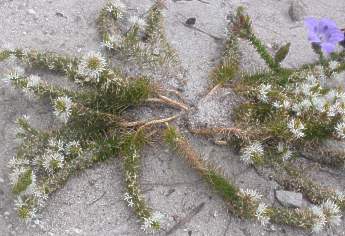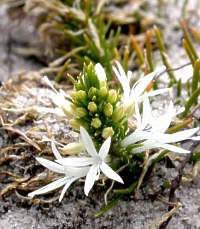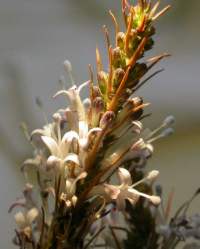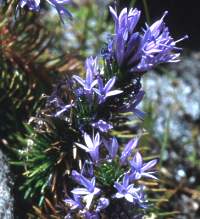Merciera
Merciera A.DC.
Family: Campanulaceae
Common names:
Introduction
Merciera, with its white or purple tubular flowers, is a little-known member of the Campanulaceae, endemic to the Cape Floristic Region.

Description
Description
All species of Merciera are re-sprouting dwarf shrubs. Vegetatively, the plants resemble Roella ciliata and its allied species. The leaves are alternate, linear and sessile, often with an axillary cluster of smaller leaves. Flowers are white or purple, solitary in the axils of the leaves. The dense arrangement of the flowers near the tip of the stems gives the appearance of a spike inflorescence. The corolla consists of a tube and 4 or 5 spreading lobes. The calyx has 4 or 5 lobes, which fuse at the base to form a very short tube. Stamens are free, 4 or 5, and inserted at the base of the corolla tube; filaments are flattened, hairy and slightly wider near the middle; anthers are linear and attached to the filament at its base. The pistil consists of an inferior 2-locular ovary, a thread-like style and a 2-lobed stigma. In each locule are 2 basal ovules; only one of the 4 ovules develops into a seed. The fruit of Merciera is an indehiscent capsule.
Distribution and habitat
Distribution description
Merciera comprises six species, all restricted to the Cape Floristic Region. The highest concentration of species is found in the Caledon division. A record of Ecklon & Zeyher from the Cape Peninsula on the Steenberg Mountains remains unconfirmed.
The species grow in open, sandy, clayey or rocky soil, often in disturbed habitats. Most species prefer lower mountain slopes.
Derivation of name and historical aspects
History
Alphonse De Candolle named the genus in honour of the botanist Phillip Mercier in 1830. He erected the genus to accommodate three species of Campanulaceae from the Cape; one of these species, Merciera tenuifolia, was previously placed in either Trachelium or Roella. Since De Candolle, authors such as H. Buek, O.W. Sonder , F.R.R. Schlechter and R.S. Adamson have contributed to the taxonomy of Merciera.
Ecology
Ecology
Fire is important in the growth and survival of the genus. After fire, the plants re-sprout from the base and a period of four to six years of vigorous vegetative growth and flowering follows. After six years, the plants become moribund and start disappearing when the veld remains unburnt for very long periods.
Mature plants usually flower regularly once a year, mainly from October to March.
Uses
Use
No economic or cultural uses have been recorded for Merciera .
Growing Merciera
Grow
Merciera lacks desirable horticultural qualities and is therefore not a suitable garden plant.
Species

M. leptoloba A.DC.
Prostrate shrublet. Leaves scattered to crowded, lower leaves longer than 8 mm. Flowers are white, the corolla tube as long as the corolla lobes. Flowering time is from November to March. This species is common on the Cape south-east coast, from Kogelberg to Bredasdorp, where it grows on sandy or rocky flats and hills.

M. tetraloba C.N.Cupido
Erect, slender shrublet. Leaves scattered and mostly ascending. Flowers white, occasionally with purple or pink tips. All floral parts are in fours, which is a unique feature. The corolla tube is much longer than the lobes. Flowering time: November to January. It grows on flats and lower mountain slopes in clayey soil. Records of this species exist for Faure, Gordon's Bay, Sir Lowry's Pass, Somerset West, Strand, Dal Josaphat, Du Toitskoof, Stellenbosch, Hermon and Malmesbury.

M. azurea Schltr.
Stout prostrate shrublet. Leaves crowded, axillary clusters of smaller leaves occasionally present. Flowers purple, corolla tube wider than in the other two purple-flowered species. Flowering time: November to February. This species ranges from Sir Lowry's Pass to Bredasdorp and occurs on sandy or stony soil.
References
- Cupido, C.N. 2002. A new species of Merciera from Western Cape , South Africa . Bothalia 32: 74-76.
- Cupido, C.N. 2003. Systematic studies in the genus Merciera (Campanulaceae): A re-assessment of species boundaries. Adansonia 25: 33-44.
- Leistner, O.A. (ed.). 2000. Seed plants of southern Africa : families and genera. Strelitzia 10. National Botanical Institute, Pretoria.
Credits
Christopher Cupido
Compton Herbarium, Kirstenbosch
December 2005
Plant Attributes:
Plant Type: Shrub
SA Distribution:
Soil type:
Flowering season:
PH:
Flower colour:
Aspect:
Gardening skill:
Special Features:
Horticultural zones






Rate this article
Article well written and informative
Rate this plant
Is this an interesting plant?
Login to add your Comment
Back to topNot registered yet? Click here to register.